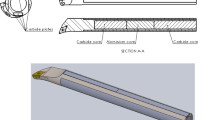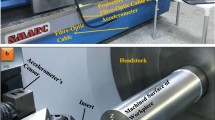Abstract
Machine tool vibrations consist of a self-stimulating mechanism during chip removal by machining operations. The system, which is a structural mode of the tool/workpiece, is initially stimulated by force. In turning operations, a wavy surface is formed on the workpiece because of both the previous revolution and structural vibrations. The maximum chip thickness may exponentially increase due to the phase shift between two consecutive waves, while the system oscillates at a chatter frequency very close to its structural mode. Variable growth in chip thickness increases vibrations, cutting forces and tool wear and causes a wavy surface. The purpose of the study is to compare different cutting tool inserts in terms of stable cutting depths. First, an experimental study was carried out and the stable cutting depths without chatter vibrations were determined in turning operations using various materials (AISI-1010, AISI-1050, Al-7075). Alumina inserts (Al2O3) were used in the study. Stable cutting depths were compared with the literature study that was performed using titanium carbide (TiC) inserts. A paired t test was used for the comparison. After the experimental study, a statistical/optimization study was performed to optimize stable cutting depths. It was observed that the chatter frequency was generally higher than the natural frequency of the cutting tool. Also, it was observed that the decrease in the number of revolutions, tool overhang lengths and yield strength of workpiece results in higher stable cutting depths. When the number of revolution is 125 rpm, the overhang length is 70 mm, and the yield strength is 124 MPa, the stable cutting depths maximize. In addition, stable cutting depths were higher when using Al2O3 cutting tool inserts and chatter vibrations were prevented. There was a significant difference between the two inserts (p < 0.05). It was found that the Al2O3 cutting tool inserts had better performances than TiC cutting inserts for the hard materials.










Similar content being viewed by others
Abbreviations
- Al2O3 :
-
Alumina
- CBN:
-
Cubic boron nitride
- C p :
-
Mallow’s coefficient
- H a :
-
Alternative hypothesis
- H 0 :
-
Null hypothesis
- k :
-
Stiffness coefficient (N/m)
- L :
-
Tool overhang length (mm)
- MRR:
-
Material removal rate
- n :
-
The number of revolution (rpm)
- PCBN:
-
Polycrystalline cubic boron nitride
- PCD:
-
Polycrystalline diamond
- R 2 :
-
Determination coefficient
- SD:
-
Stable cutting depth (mm)
- t :
-
Test statistic value
- TiC:
-
Titanium carbide
- ω c :
-
Chatter frequency (Hz)
- ω n :
-
Natural frequency (Hz)
- YS:
-
Yield strength (MPa)
- ζ :
-
Damping ratio (%)
References
Abualigah LMQ (2019) Feature selection and enhanced Krill herd algorithm for text document clustering. Studies in computational intelligence. Springer, Berlin. ISBN 978-3-030-10674-4
Abualigah LMQ, Hanandeh ES (2015) Applying genetic algorithms to information retrieval using vector space model. Int J Comput Sci Eng Appl 5(1):19
Abualigah LM, Khader AT (2017) Unsupervised text feature selection technique based on hybrid particle swarm optimization algorithm with genetic operators for the text clustering. J Supercomput 73(11):4773–4795
Abualigah LM, Khader AT, Hanandeh ES (2017) A new feature selection method to improve the document clustering using particle swarm optimization algorithm. J Comput Sci 25:456–466
Abualigah LM, Khader AT, Hanandeh ES (2018a) Hybrid clustering analysis using improved krill herd algorithm. Appl Intell 48:4047–4071
Abualigah LM, Khader AT, Hanandeh ES (2018b) A combination of objective functions and hybrid Krill herd algorithm for text document clustering analysis. Eng Appl Artif Intell 73:111–125
Altıntaş Y (2012) Manufacturing automation: metal cutting mechanics, machine tool vibrations, and CNC design. Cambridge University Press, Cambridge
Altıntaş Y, Budak E (1995) Analytical prediction of stability lobes in milling. CIRP Ann Manuf Technol 44:357–362
Altintas Y, Engin S, Budak E (1999) Analytical stability prediction and design of variable pitch cutters. J Manuf Sci Eng Trans ASME 121(2):173–178
Anmachalam RM, Mannan MA, Spowage AC (2004) Surface integrity when machining age hardened Inconel 718 with coated carbide cutting tools. Int J Mach Tools Manuf 44(14):1481–1491
Bachrathy D, Stepan G (2013) Improved prediction of stability lobes with extended multi frequency solution. CIRP Ann Manuf Technol 62:411–414
Baskar N, Asokan P, Prabhaharan G, Saravanan R (2005) Optimization of machining parameters for milling operations using non-conventional methods. Int J Adv Manuf Technol 25(11):1078–1088
Baskar N, Asokan P, Saravanan R, Prabhaharan G (2006) Selection of optimal machining parameters for multi-tool milling operations using a memetic algorithm. J Mater Process Techol 174(1):239–249
Bayly PV, Halley JE, Mann BP, Davies MA (2003) Stability of interrupted cutting by temporal finite element analysis. J Manuf Sci Eng (ASME) 125:220–225
Budak E (2000) Improving productivity and part quality in milling of titanium based impellers by chatter suppression and force control. CIRP Ann Manuf Technol 49(1):31–36
Budak E (2003) An analytical design method for milling cutters with non-constant pitch to increase stability, part 1: theory and part 2: application. J Manuf Sci Eng 125:29–38
Butcher EA, Bobrenkov OA (2011) On the Chebyshev spectral continuous time approximation for constant and periodic delay differential equations. Commun Nonlinear Sci Numer Simul 16:1541–1554
Choudhury IA, EI-Baradie MA (1999) Machinability assessment of Inconel 718 by factorial design of experiment coupled with response surface methodology. J Mater Process Technol 95:30–39
Cus F, Balic J (2003) Optimization of cutting process by GA approach. Robot Comput Integr Manuf 19(1–2):113–121
Degarmo EP, Black JT, Kohser RA (2011) DeGarmo’s materials and processes in manufacturing, 11th edn. Wiley, Hoboken
Ding Y, Zhu LM, Zhang XJ, Ding H (2010) A full-discretization method for prediction of milling stability. Int J Mach Tools Manuf 50:502–509
Ding Y, Zhu LM, Zhang XJ, Ding H (2011) Milling stability analysis using the spectral method. Sci China Technol Sci 54:3130–3136
Fazelinia H, Olgac N (2006) Optimum conditions for variable pitch milling. In: 2006 ASME international mechanical engineering congress and exposition. Illlinois
Haibin L (2007) High speed turning of nickel-based alloys. Engineering master degree thesis. Nanjing University of Aeronautics and Astronautics
Insperger T, Stepan G (2002) Semi-discretization method for delayed systems. Int J Numer Methods Eng 55:503–518
Khasawneh FA, Mann BP (2011) A spectral element approach for the stability of delay systems. Int J Numer Methods Eng 87:566–592
Koulamas C (1991) Simultaneous determination of optimal machining conditions and tool replacement policies in constrained machining economics problems by geometric programming. Int J Prod Res 29(12):2407–2421
Kurdi MH (2005) Robust multicriteria optimization of surface location error and material removal rate in high speed milling under uncertainty. Doctoral thesis Department of Mechanical and Aerospace Engineering, University of Florida
Kurdi MH, Schmitz TL, Haftka RT, Mann BP (2004) Simultaneous optimization of material removal rate and part accuracy in high speed milling. In: ASME international mechanical engineering congress and exposition (IMECE), pp 1001–1009
Li H, Li X (2000) Modelling and simulation of chatter in milling using a predictive force model. Int J Mach Tools Manuf 40(14):2047
Mann BP, Patel BR (2010) Stability of delay equations written as state space models. J Vib Control 16:1067–1085
Merdol SD, Altintas Y (2004) Multi frequency solution of chatter stability for low immersion milling. J Manuf Sci Eng (ASME) 126:459–466
Nejat O, Rifat S (2005) A unique methodology for chatter stability mapping in simultaneous machining. J Manuf Sci Eng 127(4):791–800
Neşeli S (2013) Analytical investigation of effect of process damping on chatter vibrations and optimization cutting parameters depending on stable depth of cut and process damping values in turning, Doctoral Dissertation, Department of Mechanical Engineering, Selçuk University
Neşeli S (2014) Optimization of process parameters with minimum thrust force and torque in drilling operation using Taguchi method. Adv Mech Eng. https://doi.org/10.1155/2014/925382
Neşeli S, Yaldız S, Türkeş E (2011) Optimization of tool geometry parameters for turning operations based on the response surface methodology. Measurement 44(3):580–587
Olgac N, Sipahi R (2007) Dynamic and stability of variable pitch milling. J Vib Control 13(7):1031–1043
Saikumar S, Shunmugan MS (2008) Parameter selection based on surface finish in high speed finish in high speed end milling using differential evolution. Mater Manuf Process 21(4):341–347
Schmitz TL, Smith KS (2009) Machining dynamics-frequency response to improved productivity. Springer. ISBN 978-0-387-09645-2. https://www.springer.com/gp/book/9781461499381
Shirase K, Altintas Y (1996) Cutting force and dimensional surface error generation in peripheral milling with variable pitch helical end mills. Int J Mach Tools Manuf 36(5):567–584
Sieber J, Szalai R (2011) Characteristic matrices for linear periodic delay differential equations. SIAM J Appl Dyn Syst 10:129–147
Szalai R, Stepan G, Hogan SJ (2006) Continuation of bifurcations in periodic delay-differential equations using characteristic matrices. SIAM J Sci Comput 28:1301–1317
Totis G (2009) RCPM—a new method for robust chatter prediction in milling. Int J Mach Tools Manuf 49:273–284
Tsai YC, Hsieh JM (2005) An analysis of cutting-edge curves and machining performance in the Inconel 718 machining process. The International Journal of Advanced Manufacturing Technology 25(3):248–261
Türkeş E (2007) Theoretical and experimental analysis of process damping in machine tool chatter vibration. Doctoral Dissertation, Department of Mechanical Engineering. Eskisehir Osmangazi University
Vyasarayani CP, Subhash S, Kalmar-Nagy T (2014) Spectral approximations for characteristic roots of delay differential equations. Int J Dyn Control 2:126–132
Xia W, Changfeng Y, Lei Z (2002) Study on surface roughness in turning GH4169 superalloy by using ceramic tool. Aeronaut Manuf Technol 19(12):70–72
Xinyuan L (2010) Research on the control of processing quality when cutting nickel-base superalloy at high speed. Engineering master degree thesis. Harbin Institute of Technology
Internet: www.matweb.com
Author information
Authors and Affiliations
Corresponding author
Ethics declarations
Conflict of interest
The author declares that they have no conflict of interest.
Human and animal rights
This article does not contain any studies with human participants or animals performed by the author.
Additional information
Communicated by V. Loia.
Publisher's Note
Springer Nature remains neutral with regard to jurisdictional claims in published maps and institutional affiliations.
Rights and permissions
About this article
Cite this article
Gök, F., Orak, S. & Sofuoğlu, M.A. The effect of cutting tool material on chatter vibrations and statistical optimization in turning operations. Soft Comput 24, 17319–17331 (2020). https://doi.org/10.1007/s00500-020-05022-3
Published:
Issue Date:
DOI: https://doi.org/10.1007/s00500-020-05022-3




